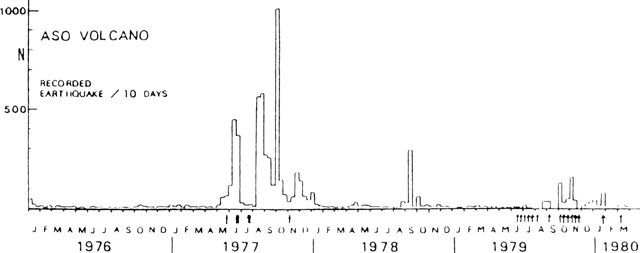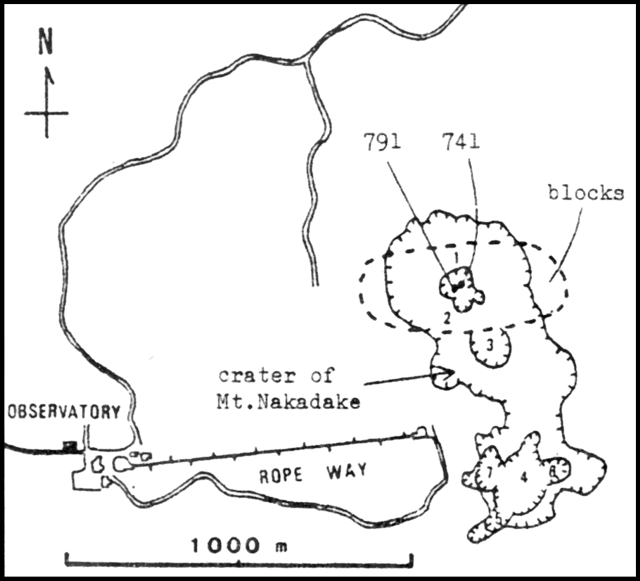Report on Asosan (Japan) — July 1979
Scientific Event Alert Network Bulletin, vol. 4, no. 7 (July 1979)
Managing Editor: David Squires.
Asosan (Japan) Moderate tephra eruption
Please cite this report as:
Global Volcanism Program, 1979. Report on Asosan (Japan) (Squires, D., ed.). Scientific Event Alert Network Bulletin, 4:7. Smithsonian Institution. https://doi.org/10.5479/si.GVP.SEAN197907-282110
Asosan
Japan
32.8849°N, 131.085°E; summit elev. 1592 m
All times are local (unless otherwise noted)
A small explosion occurred at the beginning of June from Crater 1 of Naka-dake (figure 1). Activity then declined for 10 days, although an arthquake was felt on [9] June. Loud rumbling and frequent small explosions egan on 12 June and incandescent block ejection was seen that night. At 1510 on the 13th, a larger explosion produced a 2-km-high ash column and the ejection of numerous blocks. Lightning could be seen in the ash column. Ash emission as observed until nightfall and incandescent blocks continued to be ejected every few minutes through the night of 13-14 June. A field investigation on 14 June revealed more than 10 cm of ash and many scoria bombs and blocks (up to 70 cm in diameter) in the summit area.
Frequent periods of activity, consisting of weak and continuous ash emission or explosive block ejection, occurred daily until 25 June. Incandescent coria was seen at night on the 14th, 15th, and 16th. A new vent (791 pit) was formed during the June eruption at the bottom of Crater 1 near 741 pit, which had been active since 1974 (figure 1). Since the end of June, activity has declined to occasional weak ash emission. Seismicity remained low in June, in contrast to the strongly increased seismicity that accompanied the eruptions of 1977 (figure 2).
 |
Figure 2. Number of recorded seismic events per 10-day period at Aso, January 1976-March 1980. Arrows represent eruptions. [Originally from 05:04.] Courtesy of JMA. |
Geological Summary. The 24-km-wide Asosan caldera was formed during four major explosive eruptions from 300,000 to 90,000 years ago. These produced voluminous pyroclastic flows that covered much of Kyushu. The last of these, the Aso-4 eruption, produced more than 600 km3 of airfall tephra and pyroclastic-flow deposits. A group of 17 central cones was constructed in the middle of the caldera, one of which, Nakadake, is one of Japan's most active volcanoes. It was the location of Japan's first documented historical eruption in 553 CE. The Nakadake complex has remained active throughout the Holocene. Several other cones have been active during the Holocene, including the Kometsuka scoria cone as recently as about 210 CE. Historical eruptions have largely consisted of basaltic to basaltic-andesite ash emission with periodic strombolian and phreatomagmatic activity. The summit crater of Nakadake is accessible by toll road and cable car, and is one of Kyushu's most popular tourist destinations.
Information Contacts: JMA.


